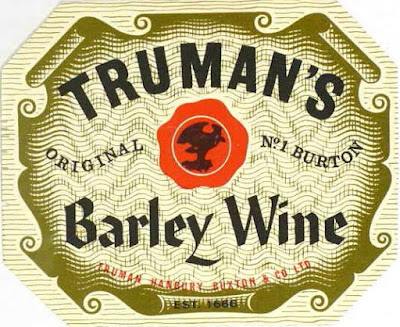Even at this late a date, Truman produced their Barley Wine in a very old-fashioned way. S1 was brewed and aged for at least 12 months. At which point R1, the running version was brewed and blended with the aged beer. This blending was done by taste, not based on fixed ratios of old and young. The idea was to produce a blend which wasn’t too acidic.
Should you wish to follow this route, the next recipe is R1.
Nothing too complicated about the recipe, simply pale malt, a touch of crystal and No. 3 invert. It differs from all Truman’s other Burton Ales in containing no flaked maize.
Of the three types of English hops, I only have information about one. Which was Brewer’s Gold from the 1959 harvest.
| 1960 Truman S1 | ||
| pale malt | 21.00 lb | 89.36% |
| crystal malt 60 L | 0.50 lb | 2.13% |
| No. 3 invert sugar | 2.00 lb | 8.51% |
| Fuggles 150 mins | 4.00 oz | |
| Brewer's Gold 60 mins | 2.25 oz | |
| Goldings 30 mins | 3.00 oz | |
| Goldings dry hops | 0.50 oz | |
| OG | 1105 | |
| FG | 1039 | |
| ABV | 8.73 | |
| Apparent attenuation | 62.86% | |
| IBU | 96 | |
| SRM | 17 | |
| Mash at | 150º F | |
| Sparge at | 160º F | |
| Boil time | 150 minutes | |
| pitching temp | 58º F | |
| Yeast | Wyeast 1099 Whitbread Ale | |



Was Newcastle Brown Ale the last commercial-scale beer to be produced by blending like this before the craft beer movement? I believe it was produced this way into the 1980s/90s.
ReplyDeleteAlmost certainly not. Brewery blends are extremely common, they are just generally not public knowledge.
ReplyDelete